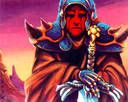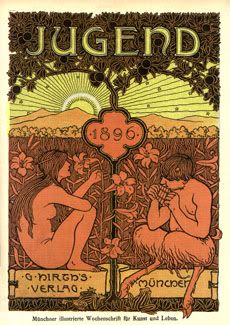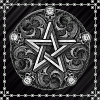Post by Jen on Jan 10, 2006 11:44:02 GMT 1
Imbolc
1st/2nd February
As people who are deeply aware of what is going on in the natural world, pagans recognise and appreciate the need for equilibrium in Nature. The turning of the wheel and the festivals celebrated throughout are both important ways that today’s modern pagan can reconnect themselves with their ancient past and the lives of their ancestors.
Imbolc is one of the four main pagan fire festivals in the year with the emphasis on Light, celebrating its return as the days grow longer with the return of the Sun. For our ancestors, Imbolc was one of the cornerstones of the calendar. For them the success of the new farming season was of great importance, the land being their means and ways for everything. As winter stores of food were getting low Imbolc rituals were performed to harness divine energy that would ensure a steady supply of food until the harvest six months later.
Imbolc literally translates as 'in the belly' and this refers to the belly (or womb) of the earth.
The ice is melting and the waters are breaking as the land becomes fertile and receptive once again.
Seeds are stirring in the ground and life is reawakening all around us. Animals come out of hibernation and spring bulbs are poking their heads through the soil. The promise of life to come is enrapturing for all.
Like many pagan festivals, the Imbolc celebrations centred around the lighting of fires. Fire was perhaps more important for this festival than others as it was also the holy day of Brigid, the Celtic Goddess of fire, healing and fertility. The lighting of fires celebrated the increasing power of the Sun over the coming months and for the Christian calendar, this holiday was reformed and renamed 'Candlemas' when candles are lit to remember the purification of the Virgin Mary.
Ways to celebrate
Many feel that human actions are at their best when they reflect the actions of nature, so as the world slowly springs back into action and wakes from its’ slumber so too should we.
This time of year is traditionally a time for purification and cleansing, which has given rise to spring-cleaning! Brush those cobwebs away and start afresh - this is a time of rebirth and new beginnings. It's also an appropriate time for thinking about what you'd like to accomplish, for making new goals or choosing a new skill to learn.
Rituals and activities might include the making of candles, lighting a fire or planting spring flowers.
You might like to make an offering of milk to the earth as a token of fertility, just pour the milk on to the ground.
Bring the Light in to your home! Lighting candles in every window is very traditional, as is leaving them to burn down. Obviously this isn't always practical, or safe, so I tend to only do this in the room I'm spending time in. Candles represent the returning light and warmth to the earth and are very appropriate for this festival.
As with all the pagan festivals a celebratory meal should be a big focus at Imbolc. Choose fresh green vegetables to represent Spring and bread, cakes and pies to represent what our ancestors would have feasted on.
BAKED CUSTARD WITH GINGER
3 Tablespoons Brown Sugar
3/4 teaspoon Finely Grated Fresh Ginger
3 large Eggs, lightly beaten
2 1/2 cups Milk
1/3 cup Granulated Sugar
1 teaspoon Vanilla Extract
1/4 teaspoon Cinnamon
1/4 teaspoon Salt
1/4 teaspoon Nutmeg
Mix brown sugar with ginger and divide evenly onto the bottoms of 6 buttered individual custard cups or ramekins.
In a medium mixing bowl, blend eggs with milk, sugar, vanilla and seasonings. Pour evenly into prepared custard cups. Place cups in a large pan, then fill with hot water to come halfway up sides of cups (a bain-marie).
Bake at 350 F. oven for 35 to 40 minutes, or until a knife inserted near the edge comes out clean. Remove cups from bain-marie. Run knife around edges to loosen. Place serving plate over top of cup and carefully invert custard onto plate. Serve warm or cover, chill and serve cold.
CANNARICULI (HONEY COOKIES)
4 cups Flour
1 cup Marsala Wine
2 Large Eggs
4 teaspoons Sugar
1 pinch Salt
Oil for deep frying
Honey
Make a well in the flour in a mixing bowl. Add wine, eggs, sugar, and salt. Mix well, until thoroughly blended. Knead dough vigorously until smooth and glossy.
Roll dough to a 1/8" thickness or less and cut into 2" squares. Starting with 1 corner, roll each square of dough loosely on the diagonal to form pastry roll about the thickness of a pencil.
Meanwhile, heat oil for deep frying. Fry pastries in batches in hot oil until golden brown, being careful not to crowd the pan. Use a slotted spoon to remove fried pastries from oil and drain on paper towels. Transfer to serving platter. Drizzle honey over top or dip them into honey.
Makes 4 to 5 dozen
LIEBKUCHEN (Honey Cakes)
1 cup margarine
1 cup sugar
1 egg
1 cup honey
1 cup sour milk* (see below)
2 Tablespoons vinegar
6 cups flour
1 1/2 teaspoon baking soda
1/2 teaspoon salt
1 teaspoon ground ginger
1/2 teaspoon mace
1 Tablespoon ground cinnamon
* For sour milk, add 1 Tablespoon vinegar to 1 cup of milk and let stand for 10 minutes.
Prepare sour milk and mix dry ingredients. Set both aside. Cream margarine and sugar, add egg and beat until light. Add honey, sour milk and vinegar. Mix thoroughly. Chill for one hour.
Roll out to 1/4" thickness.
Cut into 2"x3" rectangles and place on buttered cookie sheets. Bake at 375° for 6 minutes.
If the weather is good on Imbolc it is supposed to predict a long winter, whereas if it's bad then winter is almost over. In America Groundhog Day is on February 2nd, which is also to do with predicting when Winter will end.
If Candlemas Day is bright and clear,
There'll be two Winter's in the year.
©hedgewitch 2008
1st/2nd February
As people who are deeply aware of what is going on in the natural world, pagans recognise and appreciate the need for equilibrium in Nature. The turning of the wheel and the festivals celebrated throughout are both important ways that today’s modern pagan can reconnect themselves with their ancient past and the lives of their ancestors.
Imbolc is one of the four main pagan fire festivals in the year with the emphasis on Light, celebrating its return as the days grow longer with the return of the Sun. For our ancestors, Imbolc was one of the cornerstones of the calendar. For them the success of the new farming season was of great importance, the land being their means and ways for everything. As winter stores of food were getting low Imbolc rituals were performed to harness divine energy that would ensure a steady supply of food until the harvest six months later.
Imbolc literally translates as 'in the belly' and this refers to the belly (or womb) of the earth.
The ice is melting and the waters are breaking as the land becomes fertile and receptive once again.
Seeds are stirring in the ground and life is reawakening all around us. Animals come out of hibernation and spring bulbs are poking their heads through the soil. The promise of life to come is enrapturing for all.
Like many pagan festivals, the Imbolc celebrations centred around the lighting of fires. Fire was perhaps more important for this festival than others as it was also the holy day of Brigid, the Celtic Goddess of fire, healing and fertility. The lighting of fires celebrated the increasing power of the Sun over the coming months and for the Christian calendar, this holiday was reformed and renamed 'Candlemas' when candles are lit to remember the purification of the Virgin Mary.
Ways to celebrate
Many feel that human actions are at their best when they reflect the actions of nature, so as the world slowly springs back into action and wakes from its’ slumber so too should we.
This time of year is traditionally a time for purification and cleansing, which has given rise to spring-cleaning! Brush those cobwebs away and start afresh - this is a time of rebirth and new beginnings. It's also an appropriate time for thinking about what you'd like to accomplish, for making new goals or choosing a new skill to learn.
Rituals and activities might include the making of candles, lighting a fire or planting spring flowers.
You might like to make an offering of milk to the earth as a token of fertility, just pour the milk on to the ground.
Bring the Light in to your home! Lighting candles in every window is very traditional, as is leaving them to burn down. Obviously this isn't always practical, or safe, so I tend to only do this in the room I'm spending time in. Candles represent the returning light and warmth to the earth and are very appropriate for this festival.
As with all the pagan festivals a celebratory meal should be a big focus at Imbolc. Choose fresh green vegetables to represent Spring and bread, cakes and pies to represent what our ancestors would have feasted on.
BAKED CUSTARD WITH GINGER
3 Tablespoons Brown Sugar
3/4 teaspoon Finely Grated Fresh Ginger
3 large Eggs, lightly beaten
2 1/2 cups Milk
1/3 cup Granulated Sugar
1 teaspoon Vanilla Extract
1/4 teaspoon Cinnamon
1/4 teaspoon Salt
1/4 teaspoon Nutmeg
Mix brown sugar with ginger and divide evenly onto the bottoms of 6 buttered individual custard cups or ramekins.
In a medium mixing bowl, blend eggs with milk, sugar, vanilla and seasonings. Pour evenly into prepared custard cups. Place cups in a large pan, then fill with hot water to come halfway up sides of cups (a bain-marie).
Bake at 350 F. oven for 35 to 40 minutes, or until a knife inserted near the edge comes out clean. Remove cups from bain-marie. Run knife around edges to loosen. Place serving plate over top of cup and carefully invert custard onto plate. Serve warm or cover, chill and serve cold.
CANNARICULI (HONEY COOKIES)
4 cups Flour
1 cup Marsala Wine
2 Large Eggs
4 teaspoons Sugar
1 pinch Salt
Oil for deep frying
Honey
Make a well in the flour in a mixing bowl. Add wine, eggs, sugar, and salt. Mix well, until thoroughly blended. Knead dough vigorously until smooth and glossy.
Roll dough to a 1/8" thickness or less and cut into 2" squares. Starting with 1 corner, roll each square of dough loosely on the diagonal to form pastry roll about the thickness of a pencil.
Meanwhile, heat oil for deep frying. Fry pastries in batches in hot oil until golden brown, being careful not to crowd the pan. Use a slotted spoon to remove fried pastries from oil and drain on paper towels. Transfer to serving platter. Drizzle honey over top or dip them into honey.
Makes 4 to 5 dozen
LIEBKUCHEN (Honey Cakes)
1 cup margarine
1 cup sugar
1 egg
1 cup honey
1 cup sour milk* (see below)
2 Tablespoons vinegar
6 cups flour
1 1/2 teaspoon baking soda
1/2 teaspoon salt
1 teaspoon ground ginger
1/2 teaspoon mace
1 Tablespoon ground cinnamon
* For sour milk, add 1 Tablespoon vinegar to 1 cup of milk and let stand for 10 minutes.
Prepare sour milk and mix dry ingredients. Set both aside. Cream margarine and sugar, add egg and beat until light. Add honey, sour milk and vinegar. Mix thoroughly. Chill for one hour.
Roll out to 1/4" thickness.
Cut into 2"x3" rectangles and place on buttered cookie sheets. Bake at 375° for 6 minutes.
If the weather is good on Imbolc it is supposed to predict a long winter, whereas if it's bad then winter is almost over. In America Groundhog Day is on February 2nd, which is also to do with predicting when Winter will end.
If Candlemas Day is bright and clear,
There'll be two Winter's in the year.
©hedgewitch 2008










